![]()

Orphans of the Storm (1921)
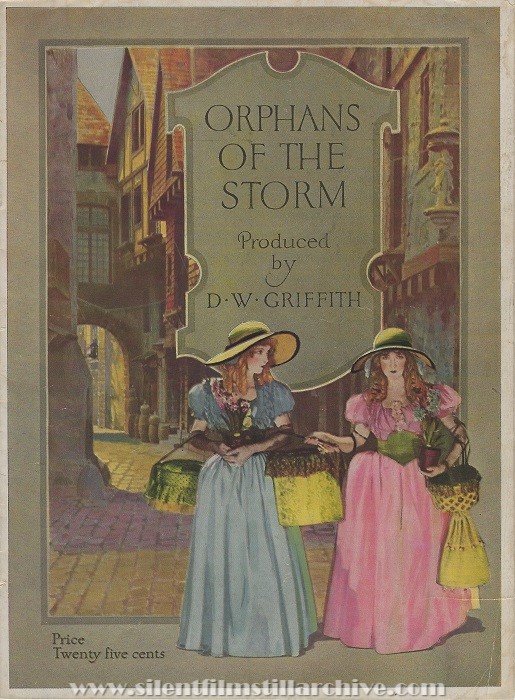
ORPHANS OF THE STORM
Produced by D. W. Griffith
Price Twenty five cents
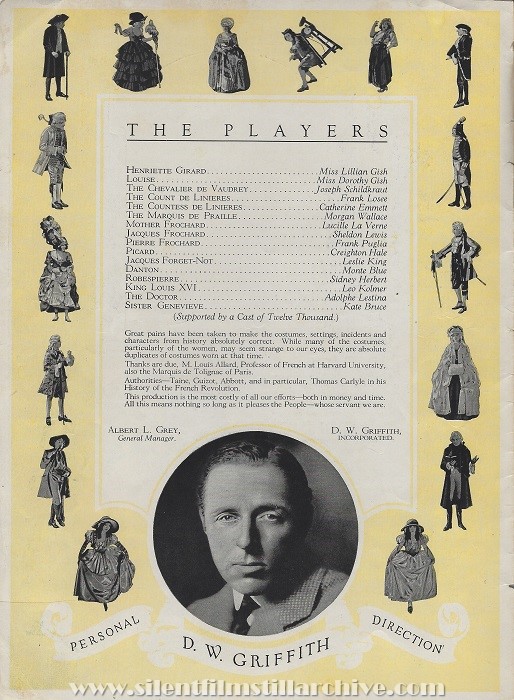
THE PLAYERS
| HENRIETTE GIRARD | Miss Lillian Gish |
| LOUISE | Miss Dorothy Gish |
| THE CHEVALIER DE VAUDREY | Joseph Schildkraut |
| THE COUNT DE LINIERES | Frank Losee |
| THE COUNTESS DE LINIERES | Catherine Emmett |
| THE MARQUIS DE PRAILLE | Morgan Wallace |
| MOTHER FROCHARD | Lucille La Verne |
| JACQUES FROCHARD | Sheldon Lewis |
| PIERRE FROCHARD | Frank Puglia |
| PICARD | Creighton Hale |
| JACQUES FORGET-NOT | Leslie King |
| DANTON | Monte Blue |
| ROBESPIERRE | Sidney Herbert |
| KING LOUIS XVI | Leo Kolmer |
| THE DOCTOR | Adolphe Lestina |
| SISTER GENEVIEVE | Kate Bruce |
(Supported by a Cast of Twelve Thousand.)
Great pains have been taken to make the costumes, settings, incidents and characters from history absolutely correct. While many of the costumes, particularly of the women, may seem strange to our eyes, they are absolute duplicates of costumes worn at the time.
Thanks are due, M. Louis Allard, Professor of Franch at Harvard University, also the Marquis de Tolignac of Paris.
Authorities -- Taine, Cuizot, Abbott, and in particular, Thomas Carlyle in his History of the French Revolution.
This production is the most costly of all our efforts -- both in money and time. All this means nothing so lang as it pleases the People -- whose servant we are.
ALBERT L. GREY, General Manager
D. W. GRIFFITH, INCORPORATED
D. W. GRIFFITH
PERSONAL DIRECTION
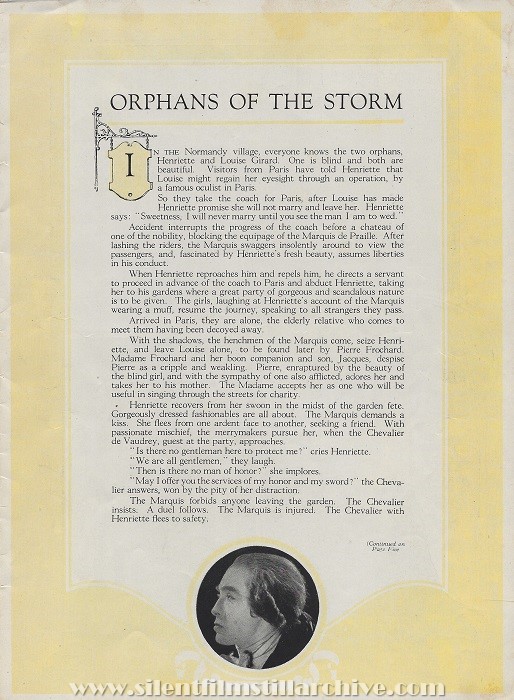
ORPHANS OF THE STORM
IN the Normandy village, everyone knows the two orphans, Henriette and Louise Girard. One is blind and both are beautiful. Visitors from Paris have told Henriette that Louise might regain her eyesight through an operation, by a famous oculist in Paris.
So they take the coach for Paris, after Louise has made henriette promise she will not marry and leave her. Henriette says: "Sweetness, I will never marry until you see the man I am to wed."
Accident interrupts the progress of the coach before a chateau of one of the nobility, blocking the equipage of the Marquis de Praille. After lashing the riders, the Marquis swaggers insolently around to view the passenger, and, fascinated by Henriette's fresh beauty, assumes liberties in his conduct.
When Henriette reproaches him and repels him, he directs a servant to proceed in advance of the coach to Paris and abduct Henriette, taking her to his gardens where a great party of gorgeous and scandalous nature is to be given. The girls, laughing at Henriette's account of the Marquis wearing a muff, resume the journey, spreking to all strangers they pass.
Arrived in Paris, they are alone, the enderly relative who comes to meet them having been decoyed away.
With the shadows, the henchmen of the Marquis come, seize Henriette, and leave Louise alone, to be found later by Pierre Frochard. Madame Frochard and her boon companion and son, Jacques, despise Pierre as a cripple and weakling. Pierre, enraptured by the beauty of the blind girl, and with the sypathy of one also afflicted, adores her and take her to his mother. The Madame accepts her as one who will be useful in singing through the streets for charity.
Henriette recovers from her swoon in the midst of the garden fete. Gorgeously dressed fashionables are all about. The Marquis demands a kiss. She flees from one ardent face to another, seeking a friend. With passionate mischief, the merrymakes pursue her, when the Chavalier de Vaudrey, quest at the party, approaches.
"Is there no gentleman here to protect me?" cries Henriette.
"We are all gentlemen," they laugh.
"Then is there no man of honor?" she implores.
"May I offer you the services of my honor and my sword?" the Chevalier answers, won by the pity of her distraction.
The Marquis forbids anyone leaving the garden. The Chevalier insists. A duel follows. The Marquis is injured. The Chevalier with Henriette flees to safety.
(Continued on Page Five)
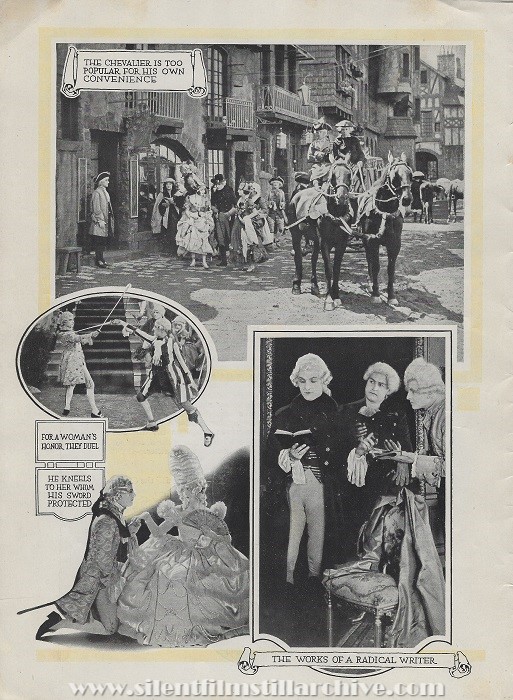
THE CHAVALIER IS TOO POPULAR FOR HIS OWN CONVENIENCE.
FOR A WOMAN'S HONOR THEY DUEL.
HE KNEELS TO HER WHOM HIS SWORD PROTECTED.
THE WORKS OF A RADICAL WRITER.
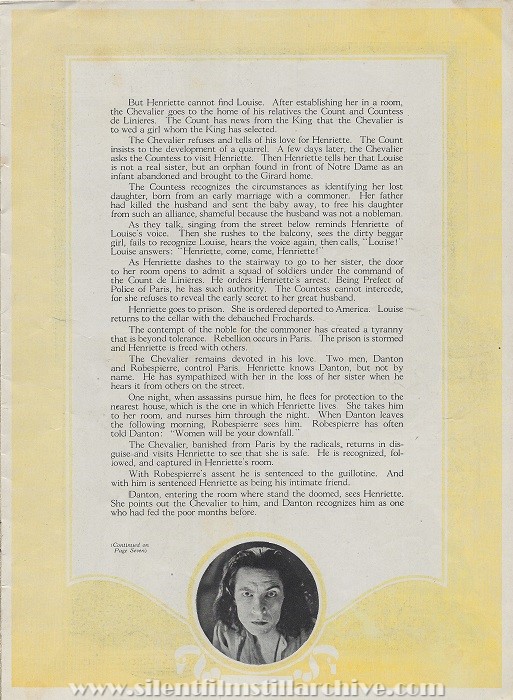
But Henriette cannot find Louise. After establishing her in a room, the Chevalier goes to the home of his relatives the Count and Countess de Linieres. The Count has news from the Kig that the Chevalier is to wed a girl whom the King has selected.
The Chevalier refuses and tells of his love for Henriette. The Count insists to the development of a quarrel. A few days later, the Chevalier asks the Countess to visit Henriette. Then Henriette tells her that Louise is not a real sister, but an orphan found i the fron of Notre Dame as an infant abandoned and brought to the Girard home.
The Countess recognizes the circumstances as identifying her lost daughter, born from an early marriage with a commoner. Her father had killed the husband and sent the baby away, to free his daughter from such an allience, shameful because the husband was not a nobleman.
As they talk, singing from the street below reminds Henriette of Louise's voice. Then she rushes to the balcony, sees the dirty beggar girl, fails to recognize Louise, hears the voice again, then calls, "Louise!" Louise answers: "Henriette, come come, Henriette!'
As Henriette dashes to the stairway to go to her sister, the door to her room opens to admit a squad of soldiers under the command of the Count de Linieres. He orders Henriette's arrest. Being Prefect of the Police of Paris, he has such authority. The Countess cannot intercede, for she refuses to reveal the early secret to her great husband.
Henriette goes to prison. She is ordered deported to America. Louise returns to the cellar with the dabauched Frochards.
The contempt of the noble for the comoner has created a tyranny that is beyond tolerance. Rebellion occurs in Paris. The prison is stormed and Henriette is freed with others.
The Chevalier remains devoted in his love. Two men, Danton and Robespierre, control Paris. Henriette knows Danton, but not by name. He has sympathized with her in the loss of her sister when he hears it from others on the street.
One night, when assassins pursue him, he flees for protection to the nearest house, which is the one in which Henriette lives. She takes him to her toom, and nurses him through the night. When Danton leaves the following morning, Robespierre sees him. Robespierre has often told Danton: "Women will be your downfall."
The Chevalier, bashished from Paris by the radicals, returns in disguise and visits Henriette to see that she is safe. He is recognized, followed, and captured in Heriette's room.
With Robespierre's assent he is sentenced to the guillotine. And with him is sentenced Henriette as being his intimate friend.
Danton, entering the room where stand the doomed, sees Henriette. She points out the Chevalier to him, and Danton recognizes him as one who had fed the poor months before.
(Continued on Page Seven)
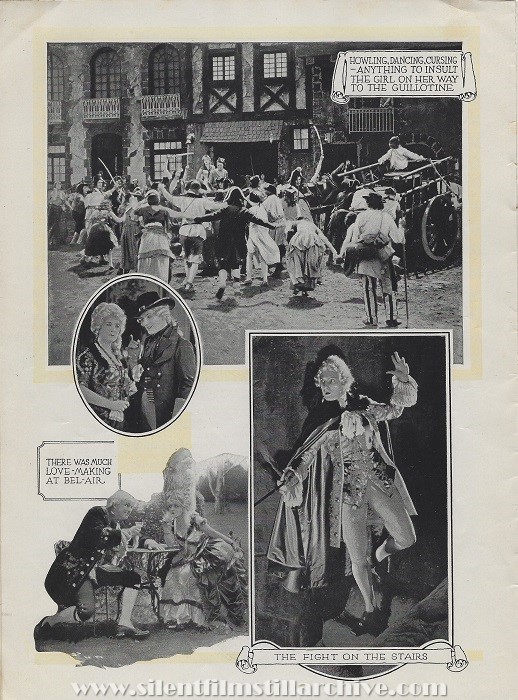
HOWLING, DANCING, CURSING -- ANYTHING TO INSULT THE GIRL ON HER WAY TO THE GUILLOTINE
THERE WAS MUCH LOVE-MAKING AT BEL-AIR
THE FIGHT ON THE STAIRS
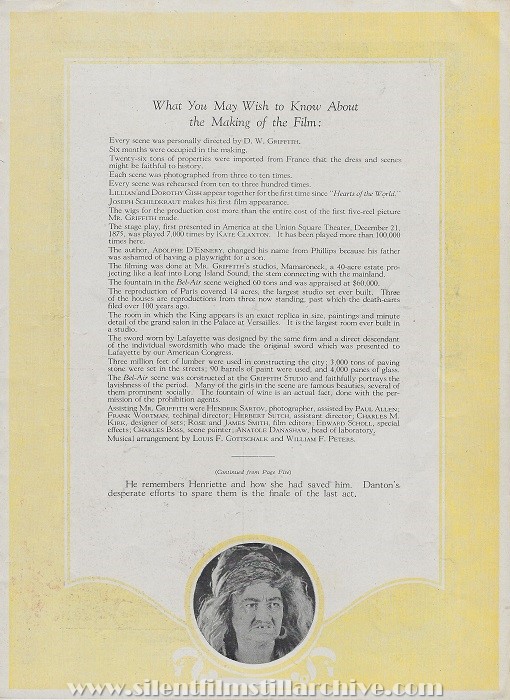
What You May Wish to Know About the Making of the Film:
Every scene was personally directed by D. W. Griffith.
Six months were occupied in the making.
Twenty-six tons of properties were imported from France that the ddress and scenes might be faithful to history.
Each scene was photographed from three to ten times.
Every scene was rehearsed from ten to three hundred times.
LILLIAN AND DOROTHY GISH appear together for the first time since "Hearts of the World."
JOSEPH SCHILDKRAUT makes his first film appearance.
THE wigs for the production cost more then the entire cost of the first five-reel picture MR. GRIFFITH made.
The stage play, first presented in America at the Union Square Theater, December 21, 1875, was played 7,000 times by KATE CLAXTON. It has been played more than 100,000 times here.
The author, ADOLPHE D'ENNERY, changed his name from Phillips ecause his father was ashamed of having a playwright for a son.
The filming was done at MR. GRIFFITH'S studios, mamaroneck, a 40-acre estate projecting like a leaf into Long island Sound, the stem conecting with the minland.
The fountain in the Bel-Air scene weighed 60 tons and was appraised at $60,000.
The reproduction of Paris covered 14 acres, the largest studio set ever built. Three of the houses are reproductions from three now standing, past which the death-carts filed over 100 years ago.
The room in which the King appears is an exact replica in size, paintings and minute detail of the grand salon in the Palace at Versailles. It is the largest room ever built in a studio.
The sword worn by Lafayette was designed by the same firm and a direct descendant of the individual swordsmith who made the original sword which was presented to Lafayette by our American Congress.
Three million feet of lunber were used in constructing the city: 3,000 tons of paving stone were set in the streets; 90 barrels of paint were used, and 4,000 panes of glass.
The Bel-Air scene was constructed at the GRIFFITH STUDIO and faithfully portrays the lavishness of the period. Many of the girls in the scene are famous beauties, several of them prominent socially. The fountain of wine is an actual fact, done with the permission of the prohibition agents.
Assisting MR. GRIFFITH were were HENDRICK SARTOV, photographer, assisted by PAUL ALLEN; FRANK WORTMAN, technical director; HERBERT SUTCH, assistant director; CHARLES M. KIRK, designer of sets; ROSE and JAMES SMITH, film editors, EDWARD SCHOLL, special effects, CHARLES BOSS, scene painter, ANATOLE DANASHAW, head of laboratory.
Musical arrangement by LOUIS F. GOTTSCHALK and WILLIAM F. PETERS.
(Continued from Page Five)
He remebers Henriette and how she had saved him. Danton's desperate efforts to spare them is the finale of the last act.
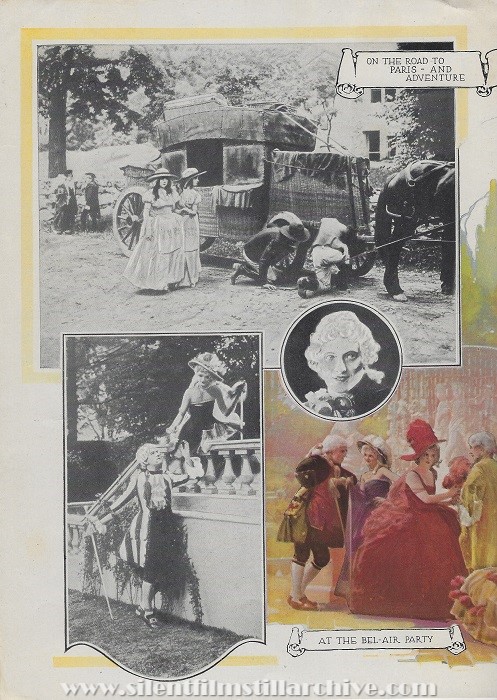
ON THE ROAD TO PARIS - AND ADVENTURE
AT THE BEL-AIR PARTY
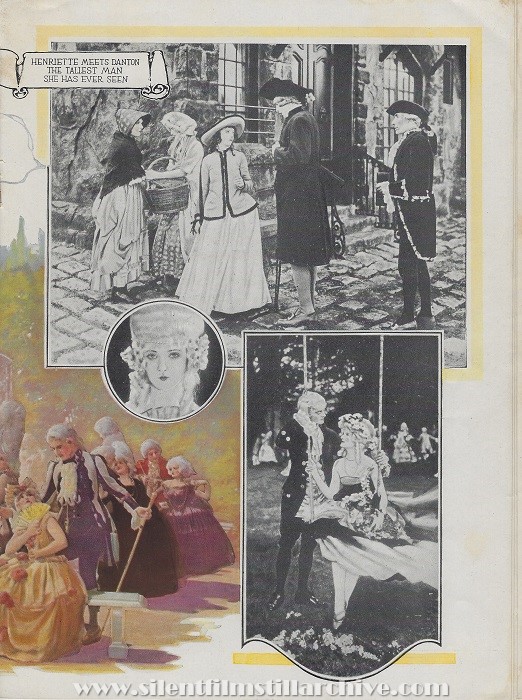
HENRIETTE MEETS DANTON THE TALLEST MAN SHE HAS EVER SEEN
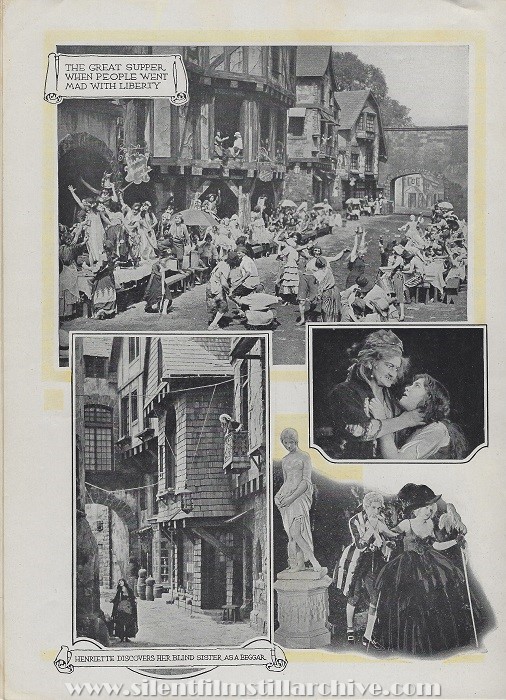
THE GREAT SUPPER WHEN PEOPLE WENT MAD WITH LIBERTY
HENRIETTE DISCOVERS HER BLIND SISTER AS A BEGGAR
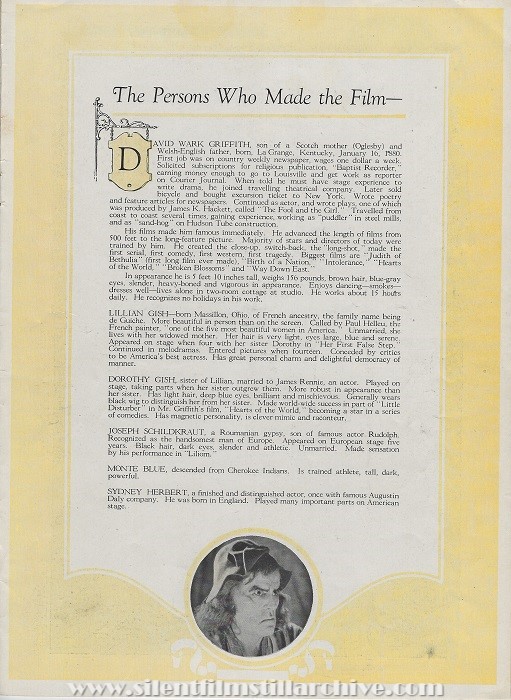
The Persons Who Made the Film -
DAVID WARK GRIFFITH, son of a Scotch mother (Oblesby) and Welsh-English father, born, La Grange, kentucky, January 16, 1880. First job was on country weekly newspaper, wages oe dollar a week. Solicited subscriptions for religious publication, "Baptist Recorder," earning money enough to go to Louisville and get work as reporter on Courier Journal. When told he must have stage experience to write drama, he joined travelling theatrical company. Leter sold bicycle and bought excursion ticket to New York. Wrote poetry and feature articles for newspapers. Continued as actor, and wrote plays, one of which was produced by James K. Hackett, called "The Fool and the Girl." Travelled from coast to coast several times, gaining experience, working as "puddler" in steel mills, and as "sand-hog" on Hudson Tube construction.
His films made him famous immediately. He advanced the length of films from 500 feet to the long-feature picture. Majority of stars and directors of today were trained by him. He created the close-up, switch-back, the "longshot," made the first serial, first comedy, first western, first tragedy. Biggest films are "Judith of Bethulia" (first long film ever made), "Birth of a Nation," "Intolerance," "Hearts of the World," "Broken Blossoms and "Way Down East.
In appearance hs is 5 feet 10 inches tall, weighs 156 pounds, brown hair, blue-gray eyes, slender, heavy-boned nd vigorous in appearance. Enjoys dancing -- smokes -- dresses well -- lives alone in two-room cottage at studio. he works about 15 hours daily. He recognizes no holiday in his work.
LILLIAN GISH -- born Massillon, Ohio, of French anscestry, the family name being de Guiche. More beautiful in person than on the screen. Called by Paul helleu, the French painter, "one of the five most eautiful women in America." Unmarried, she lives with her widowed mother. Her hair is very light, eyes large, blue and serene. Appeared on stage when four with her sister Dorothy in "Her First False Step." Continued in melodramas. Entered pictures when fourteen. Conceded by critics to be America's best actress. has great person charm and delightful democracy of manner.
DOROTHY GISH, sister of Lillian, married to James Rennie, an actor. Played on stage, taking parts where her sister outgrew them. More robust in appearance than her sister. Has light hair, deep blue eyes, brilliant and mischievous. Generally wears black wig to distinguish her from her sister. Made world-wide success in part of "Little Disturber" in Mr. Griffith's film, "Hearts of the World," becoming a star in a series of comedies. Has magnetic personality, is clever mimic and raconteur.
JOSEPH SCHILDKRAUT, a Roumanian gypsy, son of famous acor Rudolph. Recognized as the handsomest man of Europe. Appeared on European stage five years. Black hair, dark eyes, slender and athletic. Unmarried. Made sensation by his performance in "Liliom."
MONTE BLUE, descended from Cherokee Indians. Is trained athlete, tall, dark, powerful.
SYDNEY HERBERT, a finished and distinguished actor, once with famous Augustin Daly company. He was born in England. Played many important parts on American stage.
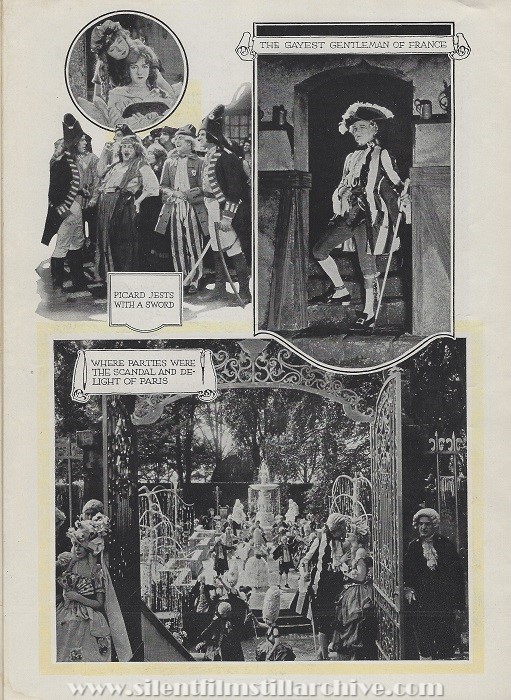
PICARD JESTS WITH A SWORD
THE GAYEST GENTLEMAN OF FRANCE
WHERE PARTIES WERE THE SCANDAL AND DELIGHT OF PARIS
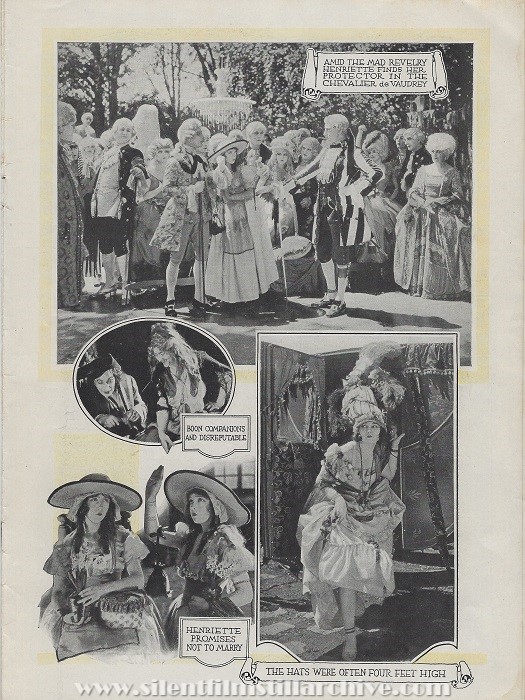
AMID THE MAD REVELRY HENRIETTE FINDS HER PROTECTOR IN THE CHEVALIER de VAUDREY
BOON COMPANIONS AND DISREPUTABLE
HENRIETTE PROMISES NOT TO MARRY
THE HATS WERE OFTEN FOUR FEET HIGH
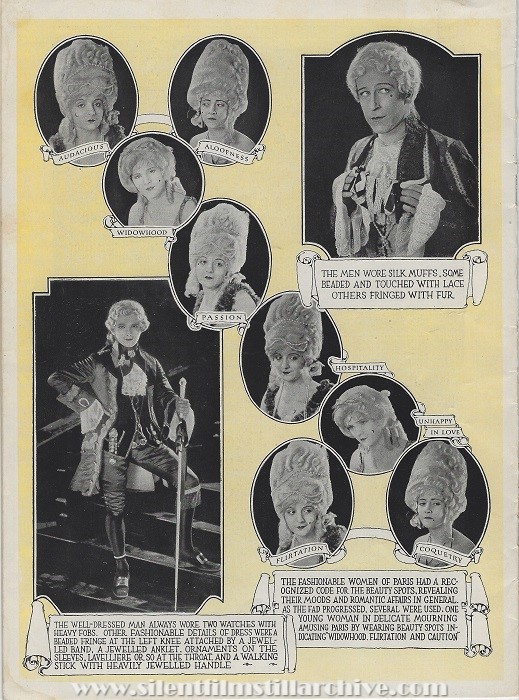
THE MEN WORE SILK MUFFS, SOME BEADED AND TOUCHED WITH LACE OTHERS FRINGED WITH FUR
AUDACIOUS ALOOFNESS
WIDOWHOOD PASSION
HOSPITALITY
FLIRTATION UNHAPPY IN LOVE
COQUETRY
THE FASHIONABLE WOMEN OF PARIS HAD A RECOGNIZED CODE FOR THE
BEAUTY SPOTS, REVEALING THEIR MOODS AND ROMANTIC AFFAIRS IN GENERAL. AS
THE FAD PROGRESSED, SEVERAL WERE USED, ON YOUNG WOMAN IN DELICATE
MOURNING AMUSING PARIS BY WEARING BEAUTY SPOTS INDICATING "WIDOWHOOD,
FLIRTATION AND CAUTION"
THE WELL-DRESSED MAN ALWAYS WORE TWO WATCHES WITH HEAVY FOBS. OTHER FASHIONABLE DETAILS OF DRESS WERE A BEADED FRINGE AT THE LEFT KNEE ATTACHED BY A JEWELLED BAND, A JEWELLED ANKLET, ORNAMENTS ON THE SLEEVES, LAVELLIERE OR SO AT THE THROAT, AND A WALKING STICK WITH HEAVILY JEWELLED HANDLE.
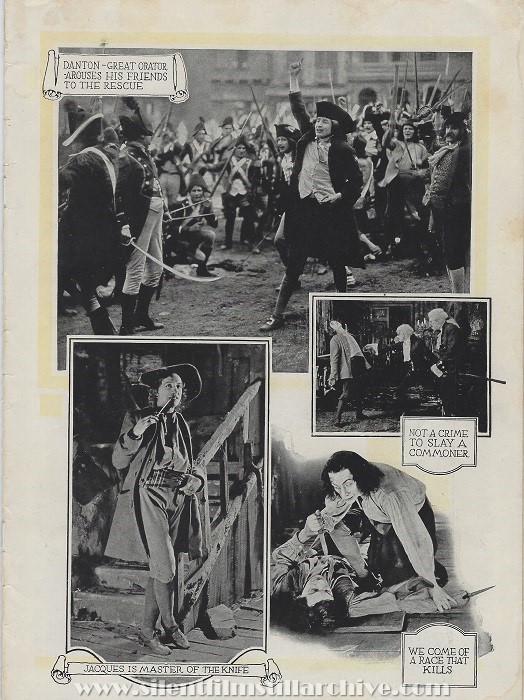
DANTON -- GREAT OREATOR AROUSES HIS FRIENDS TO THE RESCUE.
JACQUES IS MASTER OF THE KNIFE.
WE COME OF A RACE THAT KILLS.
NOT A CRIME TO SLAY A COMMONER
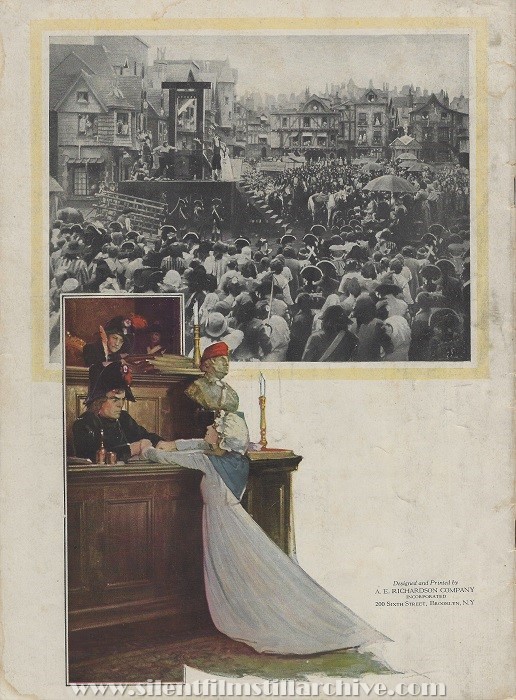
Designed and Printed for
A. E. RICHARDSON COMPANY INCORPORATED
200
SIXTH STREET, BROOKLYN, N. Y.
with Lillian Gish, Dorothy Gish, and Joseph Schildkraut. Directed by D. W. Griffith. Griffith/United Artists.
More Information on this film...

This work (Orphans of the Storm (1921),
by Griffith/United Artists), identified by
Bruce Calvert, is free of known copyright restrictions.
Books
None.
Last Modified September 7, 2020




